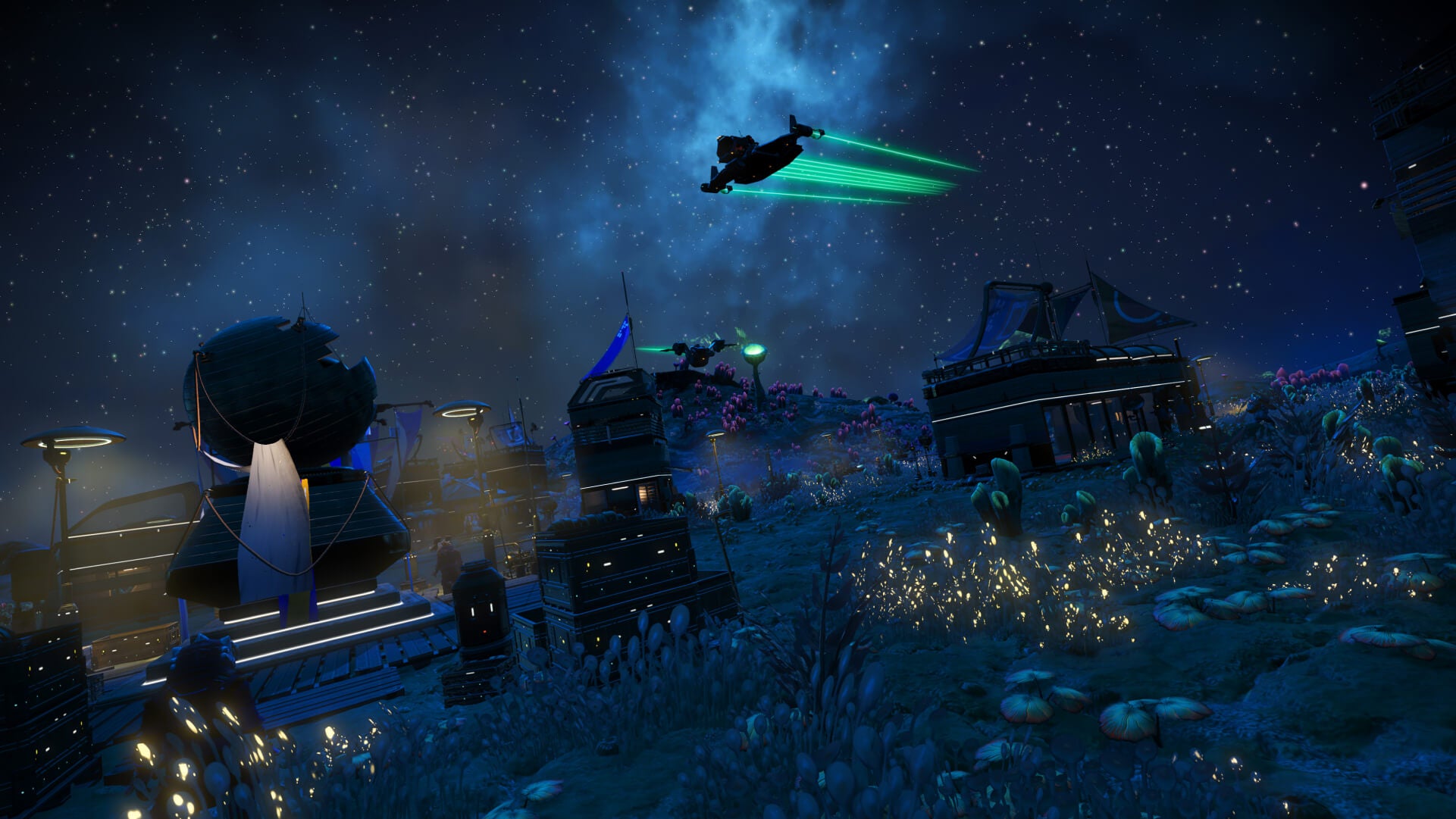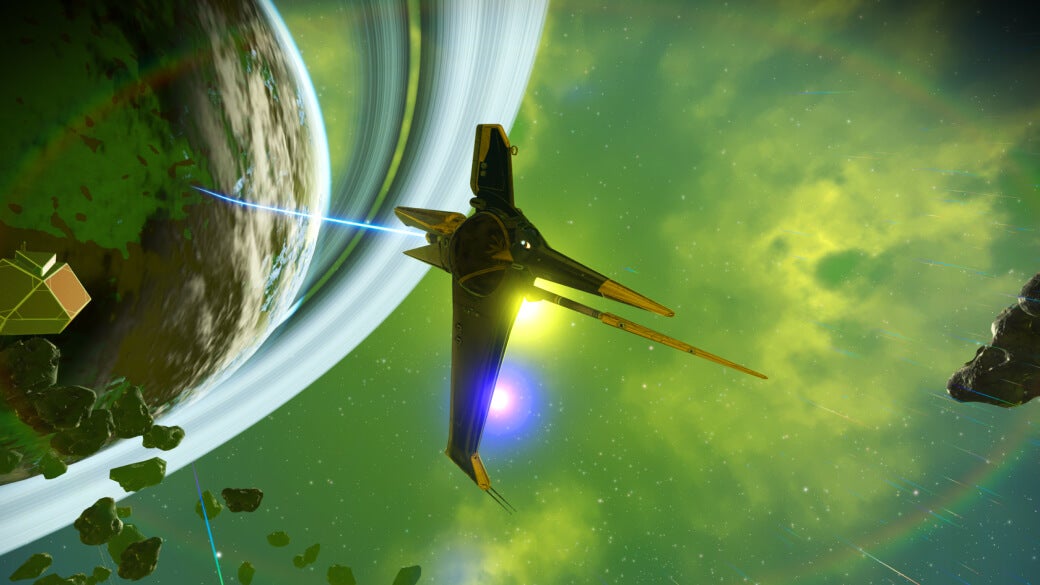In it, you will become the Overseer of your own procedurally generated alien settlement. While in this position, you will make choices, guide your citizens, develop new structures and defend your people from the Sentinels. You can also take advantage of the massive overhaul to base building to construct your own special base. The Frontiers update has introduced populated settlements to the universe, and upon encountering these communities, you can choose to help them, “ensure their future prosperity and happiness,” and eventually develop these startup settlements into towns and even into a larger urban area. If you choose to become the Overseer of a settlement, you can construct new buildings, to see your town grow which will draw new inhabitants. Citizens will need you to help solve their problems, make important decisions, keep them safely below Sentinel radars, and help defend against drone attacks. These settlements can be found naturally via a new mission that occurs after a small amount of post-tutorial progress. They can also be found with maps purchased from the Space Station Cartographer. And procedurally generated planetary settlements can be now found on inhabited planets all across the universe. Patch notes for the update are below and contain more information on Settlements, changes to Base Building, note visual improvements, contain information on save streaming, and there is also a list of bug fixes. Settlements
Mission Board missions that involve locating NPCs can also take players to settlements. Players may submit their credentials to the monument at the heart of the settlement. If accepted by the citizens, they will become Overseer of the settlement and may choose its name. Every settlement and its layout is unique. Each building is procedurally generated, using only parts available for player base building. Settlement status can be seen and managed from the central monument. Once players have constructed their Overseer’s Office, they can also manage the settlement from the terminal in their office. Settlements have five key stats: productivity, population, happiness, upkeep costs, and Sentinel alert level. Improve their stats by researching new technologies, attracting new settlers to the town, constructing new buildings, setting settlement policies, and more! Settlements, where productivity is higher than its upkeep, will generate valuable products for its Overseer to claim for themselves. Higher class settlements will produce more valuable goods. Settlements can fall into debt, for example after commissioning an expensive new piece of technology. Debt is automatically repaid from surplus production. While settlements are in debt, the Overseer may not claim the extra products. Key stat bonuses are awarded in the form of settlement features. Strong features will replace weaker ones. Once the settlement is at the feature limit, weaker features will be awarded as stat bonuses and will not replace a better feature. Over time, the Overseer will be called upon to make decisions. A new Settlers mission has been added to the log to help keep track of these requests. This mission will alert Overseers whenever they are required. Every few hours, the Overseer may be requested to make a decision. These range from greeting strangers, to resolving crimes, to setting settlement policies and research goals. These decisions will help shape your settlement into a thriving town. However, be sure to monitor the Sentinel alert level. This will rise slowly over time, and may trigger an attack on the settlement. The Overseer must be ready to defend their people! The settlement’s citizens will wander the town according to their routines. Their mood is influenced by the overall happiness of the settlement, as well as their own reactions to your decisions. Any settler may be inspected to glimpse a view at their current thoughts. Other settlers will display their thoughts as they wander, allowing the Overseer an insight into the inner lives of their citizens. Opportunities to choose a new building to construct will arise frequently. Choose which buildings to prioritize and make your settlement unique. Once a decision has been made at the terminal in the Overseer’s Office, a construction site will be placed in the settlement. Visit the site and supply resources to fuel construction. Completing the construction of buildings will also award stat bonuses.
Base Building
The base building menu has been replaced by a new grid of all available parts. The grid allows a quick and easy preview of all existing parts, as well as offering quick access to part selection. From the grid, players can select a part to place or go straight to edit mode. In placement mode, players now have quick access to scale, color, material, and rotation options. In placement mode, players can quickly cycle between related parts or can return to the parts grid to choose their next construction module. A new ‘free placement’ mode has been added. This disables snapping and allows parts to intersect with each other and still be valid to place. It also allows players to freely place parts in mid-air. From placement mode, or direct from the parts grid, players can enter Edit mode and adjust any existing parts. Simply target the part and select the appropriate option. From edit mode, parts can be duplicated for rapid construction. Or, pick up a part to fine-tune it before putting it back in place. Over 250 new base building parts have been added, from decorative to structural. Three new construction sets have been added – timber, stone, and alloy. While still versatile and easy to snap, these new sets are much higher detail and more visually diverse than the previous basic sets. These sets replace the old wood, concrete, and metal sets. The older sets are no longer available to learn but will be kept for existing players. Players who have already researched pieces from the old sets will be awarded parts from the new set for free. The new sets are significantly larger, so be sure to visit the Construction Research Station on the Space Anomaly to browse the full set. The new sets are context-aware and will automatically adjust their visuals to suit their position within a building. For example, walls placed at the top of a multi-story building may add extra trim to their tops, while walls placed at the bottom may feature extra support beams. The Exocraft signal boosters can now locate Trade Outposts. Fixed an issue that prevented the Galactic Trade Terminal from being placed on basic wall pieces. The Galactic Trade Terminal no longer needs power to function in player bases. A number of deprecated and unusable base parts have been removed from the research trees. Signal Boosters are no longer limited to one per region.
Visual Improvements
Space skies have been significantly improved, with all-new visuals for generating nebula effects. Visual effects across the entire game have been significantly improved – destruction, environmental, combat, and much more. The mode select screen has been updated with a new set of images from the community. Thank you to all the dedicated No Man’s Sky photographers! Fixed an issue that caused a single black frame during a teleport. Fixed a number of rendering issues with stars in VR.
Save Streaming
The save/load system has been overhauled. On console, each save is now treated as its own object, rather than all five save slots being bundled together. All existing saves have been automatically backed up. A number of crashes that could occur when saving or loading large and lengthy save games have been fixed. The number of possible save slots has been increased from five to fifteen. The save select screen now supports scrolling to see additional slots/start a new game. The number of discoveries that can be saved locally without uploading has been doubled. Any non-consumable Quicksilver rewards, such as gestures and base building parts, are no longer save slot specific and can be used across all save slots once purchased. Cross-save Expedition rewards, Titles, and Catalogue data will now be cloud-synced along with other save data. Multiple users on the same PC and Windows login will no longer share Expedition rewards, Titles, and Catalogue data.
Other Improvements
On the Discovery screen, improved the clarity of the button that is used to register completion of all creature discoveries on a planet. The reward for discovering all creatures on the planet has been significantly increased. The clarity of the end-of-expedition countdown has been improved. Season Three will begin soon and will bring an exciting range of new rewards.
Bug Fixes
Fixed a number of mission issues related to other players discovering the target creatures/plants/minerals. Fixed a number of issues where matchmaking with players who had adjusted their clocks would cause the Expedition to end prematurely. Fixed a number of issues that could prevent players from landing despite the location being valid. Fixed an issue that made it difficult to hover-select the final Expedition patch. Fixed an issue that caused the text on the expedition start splash screen to overlap in VR. Fixed an issue that allowed players to start a new Expedition without updating their client to the correct version. Fixed a number of mix issues with Bytebeat and background music. Fixed an animation issue that could occur when stroking a companion immediately before mounting them. Fixed an issue that caused the collision detection for biological horrors to be far too small. Fixed an issue that prevented jetpack trail names from appearing if they had not been unlocked. Fixed a number of camera issues that could occur when using a planetary chart while inside an Exocraft. Fixed an issue that caused some buildings and bases to be labeled incorrectly when entering them. Fixed an issue that could cause players to take hazard damage if their hazard protection was drained but they were no longer in the active hazard. Fixed an issue that caused some markers to have a “time to walk here” estimate despite being on another planet. Fixed a rare crash on Xbox that could prevent players from loading into the game.

